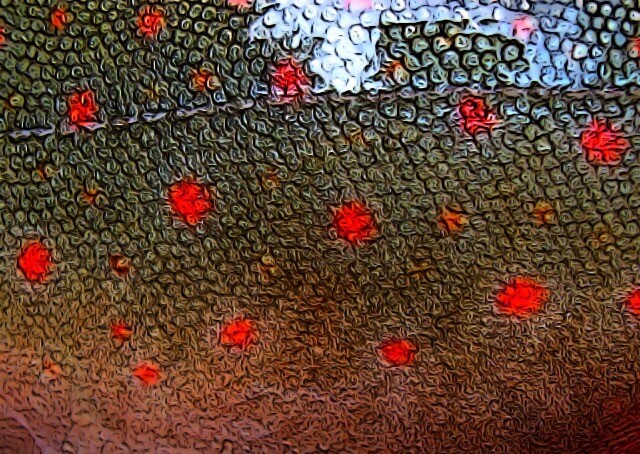Here are 6 varieties of trout (3 wild and 3 hybridized) that you don’t see every day…
WILD FISH
Orhid Trout

Orhid Trout (Pgoto: Rabnikpavik.com)
Native to Orhid Lake in the Republic of Macedonia, which used to be part of Yugoslavia, these brown trout relatives were brought to the US by the Fish & Wildlife Service because of their ability to spawn in lakes (not tributary streams). They were planted in Tennessee, Colorado, Wyoming and Minnesota and there are few if any Orchids left anywhere these days.
In Lake Orhid, these trout are on the brink of extinction due to sewage, silt and pollution flowing into the lake.
Aurora Trout

These interesting trout are a relative to brook trout (char) but lack the spots of the brookie. They originally concurred in only two lakes in Ontario…but disappeared from both in the 1960. Acid rain is presumed to be the cause of their demise.
Fish & Game managers have been raising them and releasing them into a few lakes throughout the Province. In 2003, Aurora’s were listed as Endangered in Canada.
Sevan Trout

Sevan Trout (Photo: Intechopen.com)
Native to only Lake Sevan in Armenia, the Sevan Trout is a relative of the brown trout. Unfortunately their numbers in the lake have dwindled to dangerously low levels.
According to www.fishbase.org, Two spawning stocks are known in Lake Sevan: one spawns in the northwestern corner of the lake from the beginning of November till the end of December; the other spawns at the southeastern corner, from the middle or the end of January till the end of March.
This fish approaches the lakes shorelines twice a year: from April till July and from October till December. In mid winter and at the end of summer, it leaves the shores to stay at greater depth. Adults feed heavily on sand hoppers.
HATCHERY FISH
Palomino Trout

Palomino Trout Photo: www.fishhound.com
These odd looking critters, from what I can ascertain, are a hybridized rainbow.
In 1954, a golden looking rainbow female showed up in a West Virginia hatchery that was bred with a “normal” rainbow and the offspring ended up looking like this.
By 1963 the West Virginia hatcheries had developed the strain into the “West Virginia Centennial Golden Trout,” which are planted to this day.
Blue Trout

Blue Trout (Photo: PennLive.com)
Another West Virginian oddity is the “Blue Trout,” another genetic mutation found in hatchery-reared rainbow trout.
It’s very rare, but a few are raised each year. These rainbows look much like standard rainbows, only the sport a blueish hue.
It’s thought that the blue shade comes from a mutation that causes a deficiency in the fish’s thyroid, which produces hormones that affect the fish’s coloring.
Lightning Trout

Corona Lake Lightning Trout. (Photo: www.fishinglakes.com)
Very similar to the Palomino Trout of West Virginia, “Lightning Trout” is a hybridized rainbow that originated in California’s Mount Lassen Trout facility.
Apparently, a gold-colored rainbow male was bred with standard hatchery ‘bows to create these bright yellow trout that are popular in many put-and-take lakes in the West.
